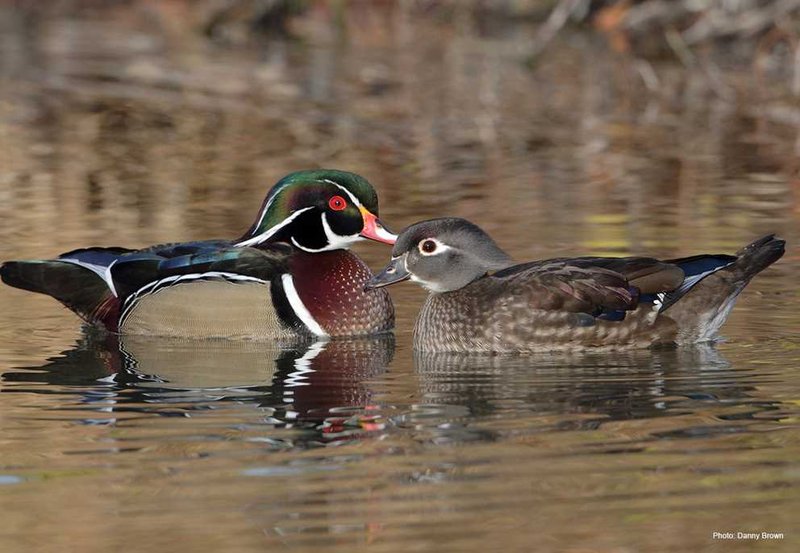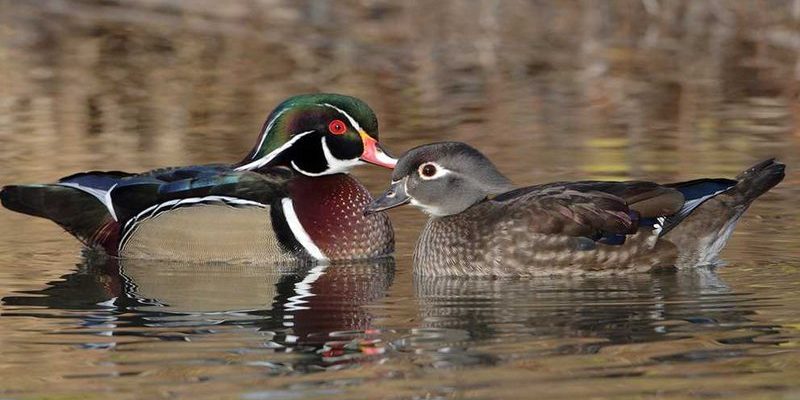
Imagine living in a place where everything is constantly changing—the seasons shift, water levels rise and fall, and the threats of predators lurk nearby. For wood ducks, adaptability is their secret weapon. They’ve developed a range of skills and traits that help them navigate their habitats effectively. Much like we adjust our plans based on the weather or our surroundings, wood ducks have their own set of remarkable adaptations that keep them thriving.
Physical Adaptations: A Colorful Camouflage
One of the first things you might notice about wood ducks is their stunning appearance. Males sport iridescent green and purple feathers, complemented by bright red eyes. This striking coloration isn’t just for show. In the wild, it serves a purpose: camouflage. When they rest among the vibrant foliage or on the water’s surface, their colors help them blend in with their natural surroundings.
Females, on the other hand, are more muted in color, with soft browns and grays. This allows them to remain inconspicuous, especially when nesting. Nesting sites are often in tree cavities or dense shrubs, making this camouflage even more crucial. Here’s the thing: their ability to hide in plain sight protects them from would-be predators, like hawks or raccoons, ensuring the safety of their young.
Furthermore, wood ducks possess strong legs and long feet, helping them navigate through wooded areas, as well as fly gracefully. They can even perch on branches—something that many other duck species can’t do. This ability lets them reach higher nesting spots, away from ground predators. Honestly, it’s like they took the best of both worlds: the waterfowl life and a little bit of the arboreal lifestyle!
Behavioral Adaptations: Nesting in Trees
Wood ducks take their nesting habits to the next level. Unlike many other ducks that nest on the ground, wood ducks prefer to find their homes in tree cavities. They’re not the only birds that do this, but their choice of nesting site makes them unique among ducks. This high nesting strategy keeps their eggs safe from many ground predators.
When it’s time to nest, females often choose cavities that are high up in trees near water. These locations provide not only safety but also quick access to the water once the ducklings hatch. You might be wondering how they choose these spots. They often look for existing holes made by woodpeckers or other birds. If you think about it, it’s a smart way to reuse nature’s designs!
After laying their eggs, the females incubate them for around 30 days. Once the ducklings hatch, they’re ready to leap! Yes, leap! They jump out of the nest directly to the ground and make their way to the water—talk about a bold first step! This instinctual behavior ensures that they can access the safety of the water quickly, showcasing yet another example of their remarkable adaptations.
Dietary Adaptations: Feeding Habits
Wood ducks are omnivorous, which means they have a varied diet that includes both plants and animals. This flexibility is crucial because it allows them to adapt to the availability of food in their environment. They mainly feed on seeds, fruits, acorns, and aquatic plants, but they also enjoy insects and small fish, especially during breeding season when they need to nourish their young.
You’d be surprised at how they often “forage” for food. Wood ducks are known for dabbling, which means they tip forward in the water to reach underwater plants without fully diving in. It’s as if they’re doing a little dance for their dinner! This feeding method is efficient and allows them to enjoy a wide range of food without putting themselves in danger.
Another interesting aspect is their preference for seasonal foods. In the spring and summer, they focus on insects and plant matter, while in fall and winter, they switch to nuts and seeds. This dietary adaptability dramatically increases their chances of survival through changing seasons.
Social Adaptations: Communication and Mating
Social interaction plays a significant role in the life of a wood duck. They communicate with each other through various vocalizations, including soft whistles and quacks, especially during the breeding season. During courting, males perform intricate displays to attract females, showcasing their colorful plumage and unique behaviors.
You might find it amusing to think of these courtship displays as the “dance moves” of the bird world. Males puff up their feathers and exhibit their best colors—much like a peacock! This visual display, combined with their vocal calls, helps them stand out and impress potential mates.
Wood ducks also tend to be quite social, often found in small groups. They can be seen congregating in areas rich in food and nesting sites, making them more likely to breed successfully. Being part of a group also offers protection—there’s safety in numbers, after all! It’s fascinating how they combine elements of independence and social structure to thrive.
Environmental Adaptations: Habitats and Migration
Wood ducks are primarily found in wooded swamps, marshes, and along lakes. Their adaptability allows them to thrive in various habitats, provided these areas have ample water and vegetation. This flexibility in habitat choice is critical; changes in their environment can impact their survival.
Interestingly, wood ducks are also migratory birds. They migrate to the southern U.S. and Mexico during the colder months, allowing them to escape harsh winter conditions. Migration isn’t just about moving to warmer places; it’s also about finding food. During winter, they seek conducive environments that provide adequate resources.
Here’s the thing: as they migrate, wood ducks often travel at night. This behavior helps reduce the chances of predation and takes advantage of cooler temperatures. It’s a strategic choice that highlights their ability to adapt to both environmental challenges and opportunities.
Conservation and Human Impact
While wood ducks are remarkable in their adaptability, they also face challenges from human activity and habitat loss. Wetland destruction and pollution can threaten their nesting sites and food sources. Thankfully, conservation efforts have been put in place to help protect these beautiful birds.
Organizations work to restore wetlands and promote sustainable practices that benefit not just wood ducks, but many other species too. By planting native vegetation and maintaining clean waterways, we can improve habitats for these ducks and help maintain their populations.
You might be wondering how you can help. Consider supporting local wildlife organizations or simply being mindful of your actions. Every little effort counts, and it can make a significant difference in preserving their habitats for future generations.
In conclusion, the wood duck is an exceptional example of nature’s ingenuity. They showcase remarkable adaptations that enable them to thrive in various environments. From their stunning physical traits to their unique nesting habits and social behaviors, these birds remind us of the beauty of adaptability. As we continue to learn more about them, let’s also do our part to protect their habitats and ensure that future generations can enjoy the wonder of wood ducks in the wild.

